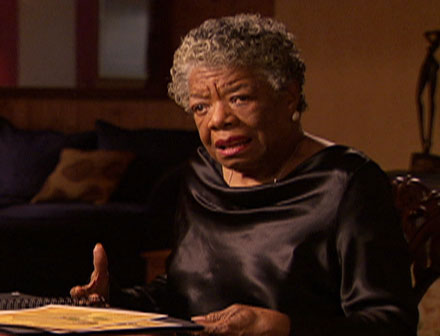Where do you even start with Maya Angelou? Part of me starts with a slight amazement of having found, while I was looking for a clip of her from her singing career, an hour and a half video of her speaking at my alma mater, when I know that the reason she wasn’t our graduation speaker in 2001 was that we couldn’t afford her. What I did also find, however, was a clip from the movie Calypso Heat Wave (also featuring Joel Grey and Alan Arkin!) where she is referred to as “Miss Calypso herself, Maya Angelou!” Which, if you are unfamiliar with her history, does indeed sound more than a bit like a Mystery Science Theater 3000 riff. But if you’ve read the books, you’re aware that she took a long road to get to the position of elder poet stateswoman that she occupied pretty much my entire life.
As assigned reading from my sophomore year told us, Maya Angelou was born Marguerite Johnson in St. Louis, Missouri. Her childhood was . . . well, we’ve read the book, most of us. Honestly, giving biographical information for Dr. Angelou, as she preferred to be called, seems a bit redundant. Especially everything up until she was about seventeen, when her son Guy was born—the time period covered in painful detail in I Know Why the Caged Bird Sings. We know about her wild mother, her strong and supportive grandmother, her protective brother—and all the people in her life who weren’t as good to her.
It is after that book draws to a close that we get to the parts of her life the average person doesn’t know as well. (It’s funny that I’d actually written a report about her my freshman year in high school—I wish I knew where it was—detailing information from her works up through All God’s Children Need Traveling Shoes, the last one written at that point. I had not yet read Caged Bird.) Caged Bird was required reading in the California schools my sophomore year in high school; I think it was required for a lot of people, though her frank description of the racism she dealt with and her own rape at age eight mean the book has also been frequently banned in schools.
But it’s after the events of that book that her life became more unusual. Sad to say, her childhood experiences are not unique. She was, during World War II, the first black female cable car operator in San Francisco history. She spent time in sex work—both in actual work and in, shall we say, management. She married a Greek man named Tosh Angelos, despite her mother’s and society’s disapproval; the relationship failed because of his expectations, however. She supported herself and her son through dancing. She released the Miss Calypso album being referred to in that quote. She joined the touring company of Porgy and Bess and indeed is in the movie.
The name “Maya Angelou” was chosen from the nickname her brother used for her and a shortening of her married name. She wrote a few songs under the name and started writing poetry under it. She performed—singing, dancing, and a little acting. She became a member of the Harlem Writers Guild, which in turn introduced her to the Civil Rights Movement. She became the northern coordinator for the Southern Christian Leadership Conference. She had a friendly relationship with Martin Luther King, Jr. She was involved with South African freedom fighter Vusumzi Make and moved with him to Africa. During her time in Ghana, she became good friends with Malcolm X.
She returned to the US to work with Malcolm X shortly before his assassination. She spent the next few years trying to find herself—and then Martin Luther King was assassinated on her fortieth birthday. Apparently, she stopped celebrating it for years and instead sent Coretta Scott King flowers. With the encouragement of another good friend, James Baldwin, among others, she wrote Caged Bird. Since one of the others was Random House editor Robert Loomis, you figure the path to publication was less difficult than it could have been.
She had, in short, one of the busiest lives of anyone we’ve covered. Oh, perhaps she didn’t do a lot of acting—though one of the things she’s known for was an appearance in Roots—but she had a weight in pop culture. For one thing, she was the mentor of Oprah Winfrey and therefore essentially the grandmother of a lot of current American culture. She also changed the field of autobiography. She’s at least as worthy of inclusion as various other people we’ve talked about over the years.
One of the ways she survived over the years was by being given a stipend by a friend for writing; be supportive like that and contribute to my Patreon or Ko-fi!

